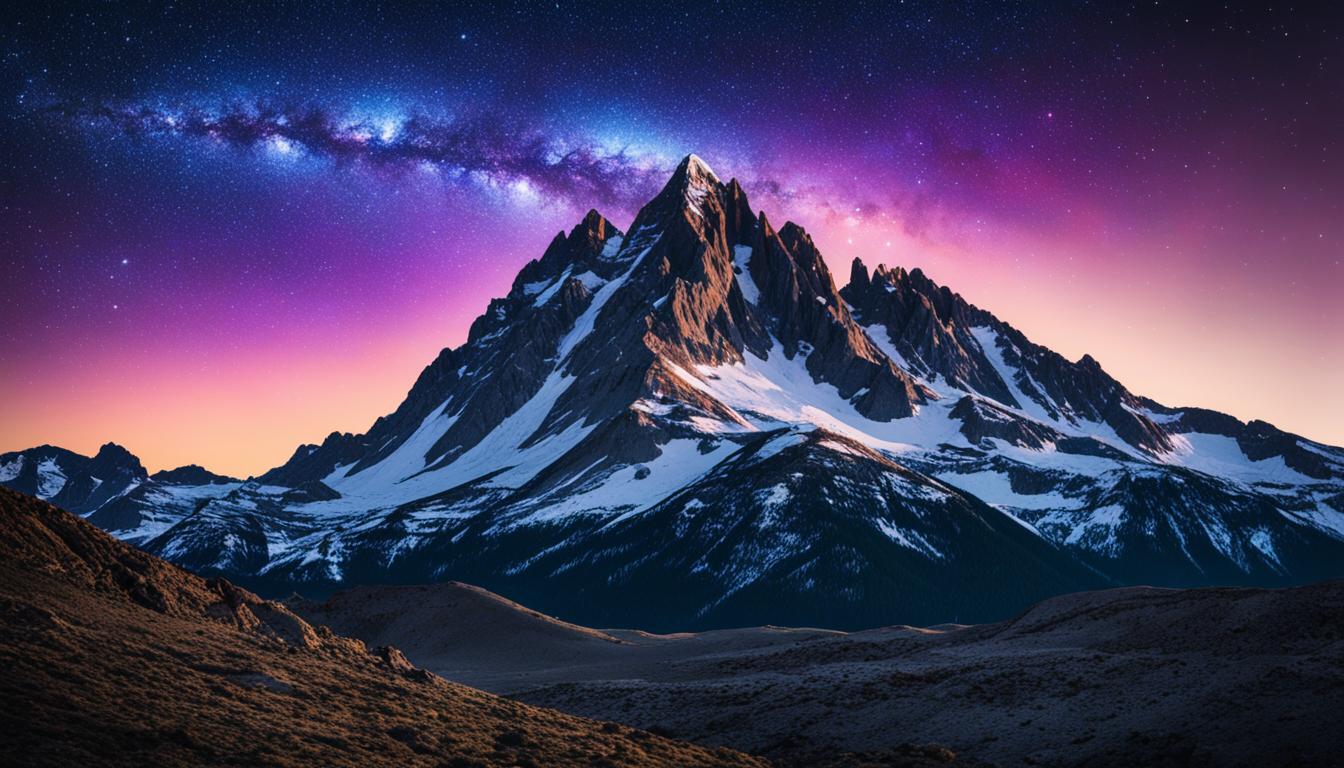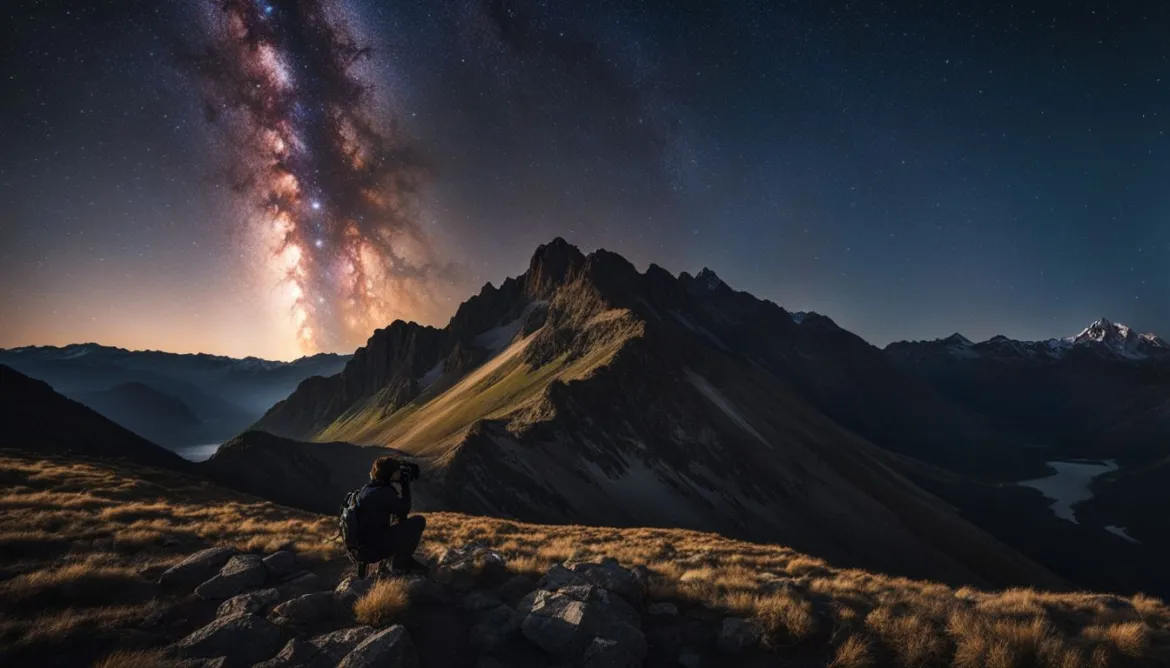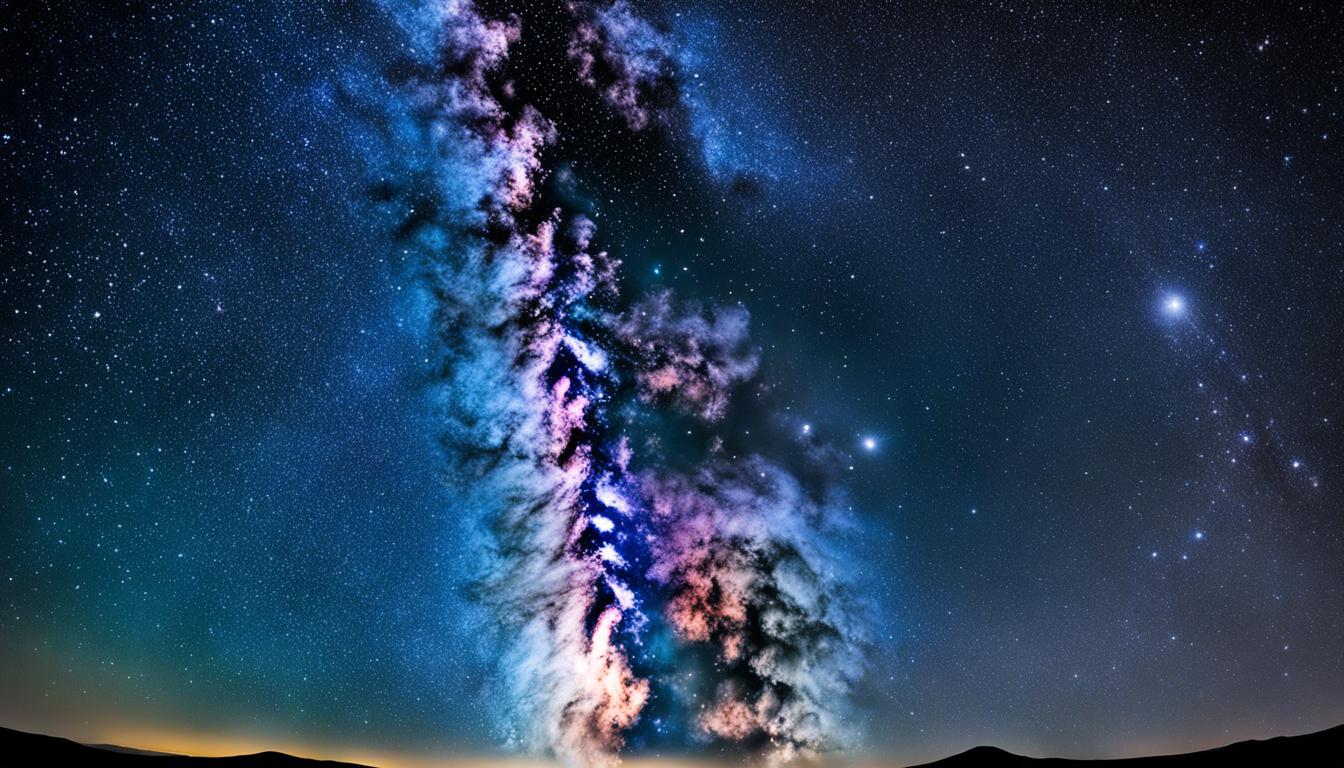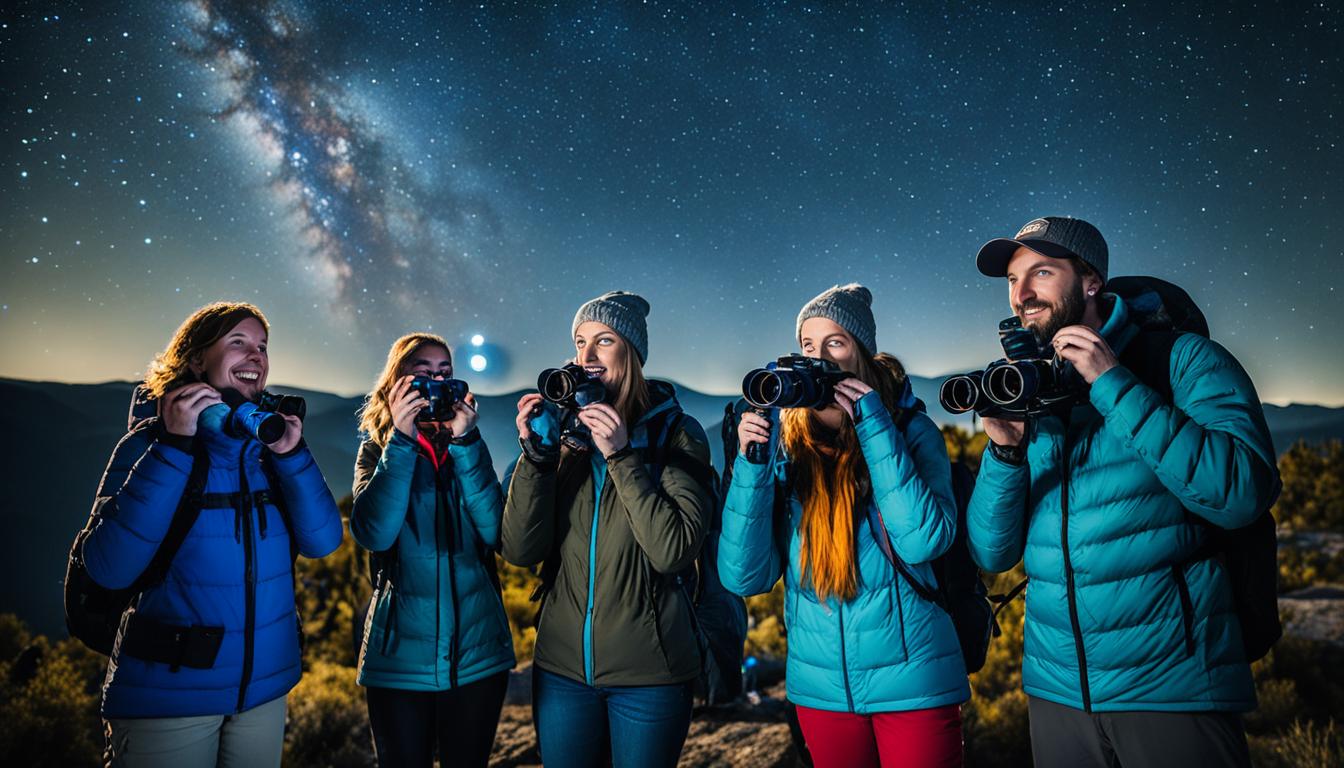Welcome to our comprehensive guide on mastering advanced composition techniques in astrophotography. Whether you’re a beginner or already have some experience, this guide will equip you with the knowledge and skills to elevate your astrophotography compositions to new heights.
Astrophotography allows us to capture the awe-inspiring beauty of the night sky, from twinkling stars and distant galaxies to celestial phenomena that leave us in awe. By mastering advanced composition techniques, you can transform your images into stunning works of art that evoke a sense of wonder and capture the essence of the cosmos.
In this section, we will delve into the intricacies of composition in astrophotography, exploring techniques that will help you create visually compelling images. From balancing exposure and utilizing negative space to incorporating leading lines and achieving symmetry, we’ll cover it all. Get ready to unlock your creative potential and capture breathtaking compositions that showcase the beauty of the cosmos.
Key Takeaways:
- Mastering advanced composition techniques is essential for creating visually compelling astrophotography compositions.
- Understanding exposure is crucial for balancing light and darkness in your images.
- Choosing the right shooting locations can greatly enhance the quality of your astrophotography compositions.
- Sharp focus and attention to detail are key elements for capturing the beauty of stars.
- Experiment with capturing the Milky Way and explore the world of deep sky photography for breathtaking results.
Understanding Exposure: Mastering Light and Darkness
In astrophotography, understanding exposure is crucial for capturing high-quality images. Factors such as aperture, shutter speed, ISO, and dynamic range play a significant role in determining the optimal camera settings for stars. By balancing exposure using the rule of thirds, achieving symmetry, and leveraging negative space, you can create visually compelling compositions in astrophotography.
When it comes to astrophotography composition, the rule of thirds is a fundamental principle. The rule of thirds involves dividing your frame into nine equal parts using two horizontal and two vertical lines, creating a grid. The intersections of these lines are known as the “power points.” Placing key elements, such as the Milky Way or a prominent star, along these power points can create a dynamic and visually pleasing composition.
Another aspect of composition to consider is balance. Achieving symmetry in your astrophotography images can enhance their overall impact. You can achieve symmetry by placing your subject, such as the night sky, at the center of your frame or by finding natural symmetrical elements, like a reflection on a lake or a row of trees.
Furthermore, don’t underestimate the power of negative space in astrophotography. Negative space refers to the area surrounding your subject that is intentionally left empty. By incorporating negative space, you can draw attention to the main subject and create a sense of depth and scale in your composition. Think of negative space as a canvas that allows your subject to shine and adds a touch of simplicity.
Mastering exposure, balance, and symmetry in astrophotography composition takes time and practice. Experiment with different camera settings, composition techniques, and the rule of thirds to find what works best for your artistic style. Remember, astrophotography is not just about capturing the stars but also about crafting captivating and visually engaging compositions that showcase the wonders of the universe.
“Composition is the art of arranging in a decorative manner the diverse elements at the painter’s command to express his feelings.” – Henri Matisse
Essential Equipment: Gear Up for Stellar Shots
To capture stunning astrophotography images, it’s essential to have the right equipment. Here’s a list of the key gear you’ll need to get started:
Camera
Invest in a DSLR or mirrorless camera with manual control capabilities and a large sensor. These cameras provide the flexibility and image quality necessary for astrophotography framing techniques.
Lens
Choose a wide-angle lens with a low focal length to capture a broad field of view and include more of the night sky in your frame. This will allow you to capture the vastness and beauty of the stars.
Tripod
A sturdy tripod is essential for keeping your camera stable during long exposures. It eliminates camera shake, resulting in sharper images. Look for a tripod with adjustable legs and a sturdy build to withstand different terrains.
Remote Shutter Release
A remote shutter release allows you to trigger the camera without physically touching it, minimizing the vibrations that can cause blurriness in your photos. It’s a valuable tool for capturing sharp and detailed astrophotography images.
Protective Cases and Lens Wipes
When venturing into the field for astrophotography, it’s important to protect your gear from the elements. Invest in protective cases to shield your camera and lenses from dust, moisture, and accidental damage. Additionally, keep lens wipes handy to ensure clear and spotless lenses for optimal image quality.
Hand Warmers
During extended astrophotography sessions in cold weather, hand warmers can provide much-needed comfort and prevent frostbite. They help keep your hands warm and nimble, allowing you to operate your camera with ease.
| Essential Equipment | Description |
|---|---|
| Camera | DSLR or mirrorless camera with manual control capabilities and a large sensor |
| Lens | Wide-angle lens with a low focal length to capture a broad field of view |
| Tripod | Sturdy tripod to keep your camera stable during long exposures |
| Remote Shutter Release | Allows you to trigger the camera without touching it, minimizing vibrations |
| Protective Cases and Lens Wipes | Protective cases to shield your gear and lens wipes for clean lenses |
| Hand Warmers | Keeps your hands warm during cold astrophotography sessions |
By equipping yourself with the right tools, you’ll be prepared to capture breathtaking astrophotography images and make the most of your cosmic adventures.

Navigating the Night: Choosing the Right Shooting Locations
Your choice of shooting location can greatly impact the quality of your astrophotography images. To capture truly captivating compositions, it’s important to consider not just the night sky but also the environment surrounding it. Here are some key factors to consider when selecting a shooting location:
1. Light Pollution: Seek Dark Skies
Avoid areas with heavy light pollution, such as urban centers or areas near bright city lights. These sources of artificial light can significantly diminish the visibility of stars and other celestial objects, resulting in less impactful images. Instead, aim for locations with dark skies and minimal light pollution for clearer and more vibrant night sky photography.
2. Interesting Horizons: Find Complementary Landscapes
Select shooting locations with interesting and unobstructed horizons to enhance your astrophotography compositions. Mountains, coastlines, open fields, or other scenic landscapes can provide a visually compelling backdrop to complement the night sky. These elements add depth and context to your images, creating a sense of harmony between the celestial and terrestrial realms.
3. Incorporate Leading Lines: Foster Creative Composition
Consider incorporating leading lines into your compositions to guide the viewer’s gaze and create a sense of depth and movement within the image. Leading lines are natural or man-made elements that lead the viewer’s eye towards the focal point of the photograph. They can be roads, rivers, fences, or any other linear features in the landscape. By strategically positioning leading lines within your frame, you can create visually dynamic and engaging astrophotography compositions.
“The leading lines in astrophotography compositions can help create a visual journey, guiding the viewer’s gaze toward the stars and immersing them in the beauty of the night sky.”
— Astrid Carter, Astrophotography Enthusiast
To plan your compositions in advance and identify potential leading lines at your chosen shooting location, you can use online tools or smartphone apps that provide augmented reality overlays or star maps. These tools can help you visualize how the night sky and leading lines align, allowing you to optimize your compositions for maximum impact.
By carefully selecting shooting locations with minimal light pollution, interesting horizons, and incorporating leading lines, you can create visually striking and creatively composed astrophotography images that captivate viewers and celebrate the wonders of the cosmos.
Focusing on the Stars: Techniques for Achieving Sharp Photos
Achieving sharp focus is crucial in capturing the beauty of stars. To ensure precise focus, we recommend switching to manual mode, which allows for full control over the focusing process. Additionally, using the Live View function and focus peaking feature on your camera can greatly assist in achieving optimal sharpness.
When refining focus, it’s important to test different focus points to find the sweet spot that brings out the details of the stars. For deep sky objects that include foreground elements, consider employing focus stacking techniques to ensure both the stars and the foreground are tack sharp.
Throughout your astrophotography session, periodically recheck focus, especially if conditions change or your camera experiences any movement. Keeping the focus sharp will result in crisp starry images that truly captivate.
Another effective technique for enhancing your astrophotography compositions is utilizing negative space. Negative space refers to the areas surrounding the main subject, which in this case, is the stars. By intentionally incorporating negative space, you can emphasize the subject and create a sense of depth and vastness in your photographs.
Remember, practice makes perfect when it comes to achieving sharp focus in astrophotography. Experiment with different techniques, be patient, and enjoy the process of capturing the mesmerizing beauty of the stars.
Capturing the Milky Way: Strategies for Astrophotography
Photographing the Milky Way galaxy is an incredible opportunity to capture the mesmerizing beauty of our universe. With the right techniques and equipment, you can create stunning astrophotography compositions that showcase the grandeur of the night sky. In this section, we’ll explore strategies and tips for capturing the Milky Way and creating visually captivating astrophotography images.
Choosing the Perfect Location
When photographing the Milky Way, it’s crucial to select locations with minimal light pollution. Dark skies provide a clear canvas for capturing the intricate details of the galaxy. Research and identify areas with low light pollution, such as national parks, remote areas, or secluded beaches. Planning shoots during the right time of year is also essential, as the visibility and position of the Milky Way vary based on the Earth’s rotation.
The Power of Wide-Angle Lenses
A wide-angle lens with a low focal length is ideal for capturing the vastness and beauty of the Milky Way. It allows you to include a larger portion of the night sky in your frame, creating a sense of awe and scale. Experiment with different focal lengths and compositions to find the perfect balance between the Milky Way and your foreground elements.
The Art of Manual Mode
To achieve the best results when photographing the Milky Way, set your camera to manual mode. This gives you full control over essential settings like ISO, aperture, and shutter speed. Start by setting a high ISO (e.g., 3200 or 6400) to capture the faint details of the stars. Adjust your aperture to a wide setting (e.g., f/2.8 or lower) to let in as much light as possible. Experiment with different shutter speeds to find the optimal balance between capturing star trails and maintaining sharpness.
Adding Leading Lines and Foreground Elements
To create visually captivating astrophotography compositions, incorporate leading lines and interesting foreground elements. Leading lines, such as roads, trails, or pathways, can guide the viewer’s eye towards the Milky Way, adding depth and visual interest to your image. Introduce compelling foreground elements, such as trees, mountains, or water, to create a sense of scale and context. This combination of leading lines and foreground elements enhances the overall composition and draws attention to the Milky Way.
Now that we’ve explored the strategies for capturing the Milky Way, it’s time to put your newfound knowledge into action. Get out there, find a location with dark skies, and experiment with different compositions and settings to create awe-inspiring astrophotography images of the Milky Way galaxy.

| Key Strategies for Milky Way Astrophotography | Benefits |
|---|---|
| Choose locations with minimal light pollution | Clear and detailed Milky Way images |
| Use a wide-angle lens with a low focal length | Capturing the vastness of the night sky |
| Set your camera to manual mode and experiment with settings | Full control over exposure and image quality |
| Incorporate leading lines and foreground elements | Enhanced composition and visual interest |
Deep Sky Photography: Unveiling Celestial Objects Beyond Our Solar System
Deep sky photography allows us to capture the captivating beauty of celestial objects beyond our solar system. By venturing into the depths of space, we can reveal stunning nebulae, galaxies, and star clusters that exist far beyond our reach. To embark on this cosmic journey, we need the right astrophotography gear to help us in our quest for celestial discovery.
Camera and Lenses
An essential part of deep sky photography is a camera with manual control capabilities and a large sensor. This will enable us to have full control over the settings and capture intricate details of distant celestial objects. Additionally, having a range of lenses suitable for different types of objects is crucial. Wide-angle lenses are ideal for capturing expansive views of the night sky, while telephoto lenses help us zoom in on specific targets.
Tripod and Mounts
Stability is paramount in deep sky photography. A sturdy tripod is necessary to keep our camera steady during long exposures, preventing blurriness in our images. Furthermore, using various types of mounts, such as equatorial or alt-azimuth mounts, can help us achieve accurate tracking of celestial objects as they move across the sky. This tracking capability allows us to capture sharp and detailed images over extended periods.
Deep Sky Filters
Deep sky filters are valuable tools for enhancing image quality and bringing out fascinating details in our captures. These filters help block unwanted light pollution and increase contrast, allowing us to capture clearer and more vibrant images of distant celestial objects.
Essential Accessories
In our pursuit of deep sky photography, it’s essential to be well-prepared with the right accessories. Here are a few items that can enhance our experience and ensure a smooth workflow:
- A headlamp for hands-free operation in low-light conditions.
- Heat tape to prevent dew formation on lenses during long exposures.
- Extra batteries to keep our equipment powered throughout our astrophotography sessions.
With the right astrophotography gear and a sense of wonder, we can unravel the mysteries of the cosmos through deep sky photography. Let us equip ourselves with the tools and knowledge needed to venture into the vast expanse of the universe and capture the awe-inspiring beauty that awaits us.
Conclusion
Astrophotography is a captivating pursuit that allows us to capture the awe-inspiring beauty of the night sky. By mastering advanced composition techniques, understanding exposure, and using the right equipment, we can elevate our astrophotography skills to new heights.
Choosing the right shooting locations is crucial in creating stunning images. Seek out dark skies with minimal light pollution to enhance the clarity and vibrancy of the celestial objects. Consider incorporating leading lines and creative composition techniques to add depth and visual interest to your astrophotography compositions.
Furthermore, achieving sharp photos is essential in astrophotography. Take advantage of manual mode and utilize the camera’s Live View function to fine-tune focus. By using negative space, we can accentuate the brilliance of the stars and emphasize their intrinsic beauty.
Lastly, don’t forget to explore the realm of deep sky photography. Unveil the wonders of nebulae, galaxies, and star clusters beyond our solar system. With dedication and practice, we can create breathtaking compositions that balance symmetry, utilize negative space, and celebrate the harmonious majesty of the cosmos.
FAQ
What are some advanced composition techniques in astrophotography?
Advanced composition techniques in astrophotography include the rule of thirds, balance and symmetry, leading lines, negative space, and framing techniques.
Why is understanding exposure important in astrophotography?
Understanding exposure is crucial in astrophotography because it helps in capturing high-quality images. Factors such as aperture, shutter speed, ISO, and dynamic range play a significant role in determining optimal camera settings for capturing stars.
What equipment is essential for astrophotography?
Essential equipment for astrophotography includes a DSLR or mirrorless camera with manual control capabilities and a large sensor, a wide-angle lens with a low focal length, a sturdy tripod for stability, and a remote shutter release to minimize vibration.
How can I choose the right shooting locations for astrophotography?
To choose the right shooting locations for astrophotography, avoid areas with heavy light pollution and opt for dark skies with minimal artificial light. Select locations with interesting and unobstructed horizons, such as mountains, coastlines, or open fields, to complement the night sky.
What techniques can I use to achieve sharp photos in astrophotography?
To achieve sharp photos in astrophotography, switch to manual mode for full control over focusing, use the camera’s Live View function and focus peaking, test different focus points, consider focus stacking for deep sky objects with foreground elements, and periodically recheck focus during your astrophotography session.
How can I capture the beauty of the Milky Way in my astrophotography?
To capture the beauty of the Milky Way in astrophotography, choose locations with minimal light pollution, plan shoots during the right time of year, use a wide-angle lens with a low focal length, set the camera to manual mode, and experiment with ISO, aperture, and shutter speed settings. Incorporate leading lines and interesting foreground elements to create visually stunning compositions.
What is deep sky photography, and how can I get started?
Deep sky photography focuses on capturing celestial objects beyond our solar system, such as nebulae, galaxies, and star clusters. To get started, equip yourself with a camera with manual control capabilities and a large sensor, suitable lenses for different types of objects, a sturdy tripod, and consider utilizing deep sky filters. Plan your shoots in dark locations, use accurate tracking mounts, and bring essential accessories for a successful session.
How can I improve my astrophotography composition skills?
To improve your astrophotography composition skills, master advanced composition techniques such as the rule of thirds, balance and symmetry, leading lines, negative space, and framing techniques. Practice capturing the beauty of the night sky, experiment with different shooting locations, and continue to refine your skills through dedication and practice.
What Advanced Composition Techniques Are Useful for Deep Sky Astrophotography?
When it comes to deep sky astrophotography, some useful tips include using narrowband filters to isolate specific wavelengths of light, employing autoguiding to maintain precise tracking, and stacking multiple exposures to reduce noise and enhance details. These advanced composition techniques can greatly improve the quality of deep sky astrophotography images.




